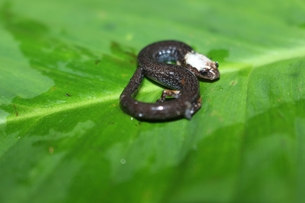Now - more than 100 years since the first documentation in Ecuador - further specimens of Oedipina from the northwestern part of the country could finally be found. This shows on the one hand how extremely rare the representatives of the genus are, but also how little attention has been paid so far to these relatively small salamanders with slender, elongated bodies, long tails, and short limbs.
"The two newly described species are only known from two provinces, and there are only three records of the genus from Ecuador" explains Carolina Reyes-Puig, first author of the description of the new species published in the journal PeerJ. Due to the small distribution area, increasing deforestation in the regions, and distribution of current and projected mining concessions, the researchers suspect that the habitat quality will continue to decline. They therefore suggest that O. villamizariorum and O. ecuatoriana should be classified as "critically endangered" in the IUCN Red List of Threatened Species.
Parts of the team conducted studies at two locations in the northwestern foothills of Ecuador. However, despite intensive searches, only one individual of a new species of Oedipina could be found there. The researchers then examined material in various museum collections. In the Museum of Natural History in London they found another individual. The research team initially assumed that it was a second specimen of the species that had previously been caught in the field by the researchers themselves. "Investigations of the skull and hand bones using CT scans, which were carried out partly in London and partly at the Zoological Research Museum Alexander Koenig - Leibniz Institute for Biodiversity Research (ZFMK, Museum Koenig) in Bonn, revealed, however, that the two individuals were different species in each case," explains Dr. Claudia Koch, curator for herpetology at the ZFMK and co-author of the article.
Oedipina villamizariorum, as the species captured near the Dracula Reserve of the EcoMinga Foundation in the province of Carchi was named, is a medium-sized salamander with a snout-vent length of 42.1 mm and is characterized by a narrow and relatively pointed head. Its fingers are moderately long and pointed. The species inhabits the lowland forests of the Ecuadorian Chocó.
The second species, Oedipina ecuatoriana, was described using the specimen found in the London collection, which is said to come from the province of Imbabura. Since this animal was captured by a professional collector and not by the researchers themselves, it can only be assumed that the collector's information is correct and that the species inhabits the mountain forests of the Chocó lowlands. This species is slightly larger than the previous species with a snout-vent length of 45.6 mm and has a rounded snout. It differs from other Oedipina species by a reduced phalangeal formula and by the presence of prefrontal bones, which are missing in all known Oedipina species.
Possibly even a third species was discovered. A further specimen of an Ecuadorian Oedipina was found in the collection of the Fundación Herpetológica Gustavo Órces in Quito, Ecuador. This animal is more similar to Oedipina villamizariorum but shows some differences to this species. The researchers therefore suspect that this could be another new Ecuadorian species but point out that more data needs to be collected to clarify its status.
Literature
Reyes-Puig, C., Wake, D. B., Kotharambath, R., Streicher, J. W., Koch, C., Cisneros-Heredia, D. F., Yánez-Muñoz, M. H., Ron, S. (2020): Two extremely rare new species of fossorial salamanders of the genus Oedipina (Plethodontidae) from northwestern Ecuador. PeerJ 8:e9934;
http://doi.org/10.7717/peerj.9934
Figure acption:
Life coloration of Oedipina villamizariorum sp. n. from the Ecuadorian province of Carchi.
Copyright: Carolina Reyes-Puig
The use of the photos for journalistic reporting about this press release is free-of-charge. please include the copyright details
Contact
Dr. Claudia Koch
Curator Herpetology
Radiation Protection Officer
Animal Welfare Officer
Herpetology
Tel: +49 228 9122-234
Fax: +49 228 9122-212
Mail: c.koch [at] leibniz-zfmk.de
Zoological Research Museum Alexander Koenig – Leibniz-Institute for Animal Biodiversity (ZFMK) is an independent research institute. The focus of research is on performing an inventory of the zoological species diversity on earth, on the analysis of changes in biodiversity as a result of environmental factors, and on evolutionary processes at the morphological and molecular levels. ZFMK furthermore explores the context of structure and function of ecological systems, advanced scientific methods, and the study of the history of science. The permanent exhibition “Our blue planet – the living network” offers a genuine nature experience based on naturalistic ecosystem displays.
The Leibniz Association combines 96 independent research institutes. Their focus ranges from the natural, engineering, and environmental sciences to the humanities and the business, space, and social sciences. The Leibniz institutes focus on relevant social, economic, and ecological issues. They perform knowledge-oriented and applied research (also among the cross-disciplinary Leibniz research alliances), are or support scientific infrastructures, and offer research-based services.








